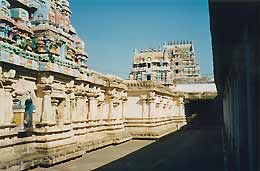 |
Kumbakonam is one of the
oldest towns in South India. In 7th century it was the capitol of
Chola kings. |
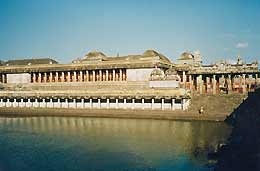 |
Rivers Kaveri (Chauvery)
and Arasalar flow from both sides of the town. |
 |
In the center of the city there are 18 temples mostly dedicated
to Vishnu and Shiva. There is also one rare temple of demigod
Brahma.
|
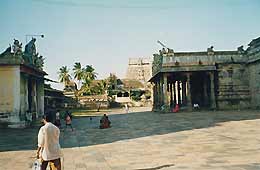 |
Kumbakonam is named after
demon Kumbakarna, Ravana's brother, but the name has also relation
to Shiva's temple Adi Kumbeswara. |
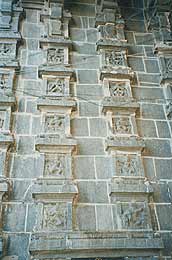 |
Adi Kumbeswara Temple
is the biggest Shiva's temple in the city. Its gopuram is 38 m high
and it is decorated with many sculptures. |
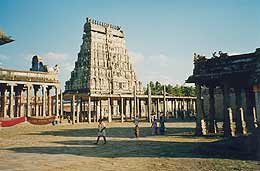 |
The Shiva-linga in Adi Kumbeswara temple has a shape of the pot
(in Sanskrit "kumbha"). Demigod Brahma got a pot with
the seed of creation from Lord Shiva and during the flood the
pot floated from Kailash to the south. In the place of present
Kumbakonam it was hit by Shiva's arrow who struck it disguised
as hunter. The content of the pot (amirtham) was mixed with the
sand and in this way emerged Shiva-linga now worshipped in the
temple.
|
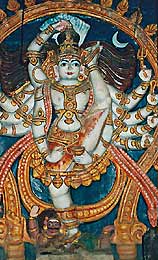 |
Also here, in Adi Kumbeswara temple, we can see a sculpture of
dancing Shiva in ananda-tandava posture, in which he won a dancing
conquest with Kali. No wonder, Cidambaram, the Nataraja's quarters,
is just 60 km from here.
|
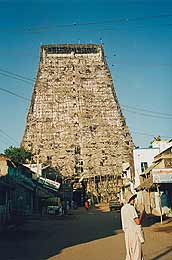 |
Sarangapani Temple
is one of the most important Vishnu temples in South India (the
others are Sri Rangam and Tirupati). Seven Alvars, important
personalities from Shri sampradaya, sung the glories of this temple.
It was built from 13th to 17th century by Nayak kings, but the inner
sanctum is older and it dates back to the beginning of their era.
Gopuram is 44 m high. South gate is used as the entrance in times
when sun is on the southern hemisphere and northern gate serves
as the entrance when sun travels north.
There are many Deities in the temple and we can find also the sanctum
of Komalavalli (Lakshmi) a Pathala Shrinivas (Vishnu). |
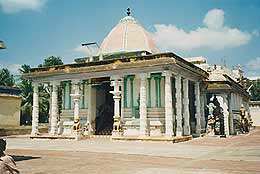 |
History of the temple is connected with the story from Krishna
book. The sages headed by Maharishi Saunaka on the banks of Sarasvati
wanted to find out which god is the highest. They send Bhrigu
Muni to visit them and test them. At the end Bhrigu pronounced
Vishnu as the greatest since He didn't loose His temper even after
being kicked by Bhrigu in the chest. Vishnu on the contrary welcomed
Bhrigu with sweet words and gave him honor proper to a visiting
brahmana...
|
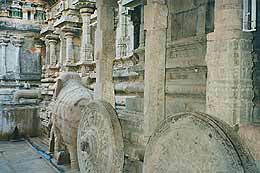 |
After that incident Bhrigu regretted his offence and prayed to
be able to serve the Lord in two next births. In Ramacandra's
pastimes he was Guha and thereafter he was born as the sage Hima.
Himarishi prayed for Shri Vishnu's help in a place of present
Kumbakonam and Vishnu descended on Earth in His chariot. The central
sanctum and mandapa (hallway) of the temple has the shape of a
chariot and in the basement wheels and elephant pulling the chariot
are clearly visible...
|
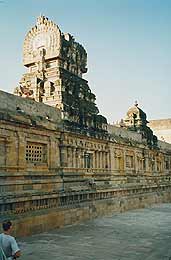 |
Bhrigu also got the blessing to have Lakshmi as his daughter.
In this way Lakshmi could be reunited with her husband Shri Vishnu,
since she couldn't tolerate Bhrigu's insult towards Vishnu in
her presence and left.
Another important temple is Nagesvara Temple with the statue
of Dakshinamurti (Shiva as the teacher) and Adranarishvara (Shiva
as half men half woman). In this temple sun rays falls directly
on Shiva-linga on the main altar and it is said that sun-god Surya
in this way worships Lord Shiva.
|
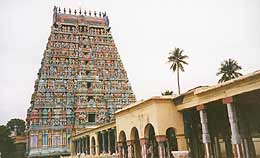 |
Ram Swami Temple
was built in 16th and 17th century by Nayak king Raghunath. The
main Deities are Sita, Ram, Lakshman, Satrugna (His brothers) and
Hanuman. Deities are from the black stone decorated with silver
paraphernalia. On the road to the temple and on the walls and towers,
there are many paintings and sculptures with the scenes from Ramayana. |
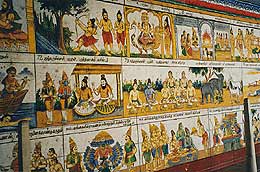 |
In right down corner of this wall painting there is Hanuman bringing
the Himalayan mountain to rescue his Lord Ramacandra. Here is
the whole story...
Hanuman and Pushpa-samjivani: Ravana's son Indrajit
fought with many mystic weapons during the Battle of Lanka. He
could be invisible for others and by his special snake weapon
he made Ram and Lakshman unconscious...
|
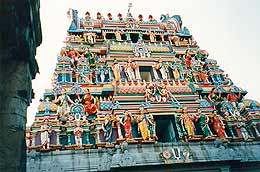 |
...The physician from Varana
army and Vibhishana advised Hanuman to bring medical plant Pushpa-samjivani
from one Himalayan mountain "Pushpa-samjivani" means "the
flower of revitalization" and its leaves had such power that
by eating it one didn't feel hunger and thirst for 5 years. One
didn't get sick also and furthermore it had the power to bring one
back to live. The Pushpa-samjivani plant could be recognized by
its special glare... |
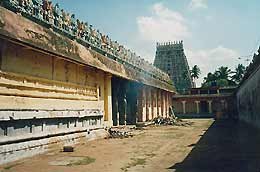 |
...Local rishis were often
taking advantage of it, because by its power they could meditate
undisturbed for years. When they saw Hanuman approaching, they knew
that he wants Pushpa-samjivani, because there was nothing else interesting
- just sages meditating with closed eyes. They began to fear about
their plant and by their mystic power they caused all the plants
on the mountain to look as Pushpa-samjivani... |
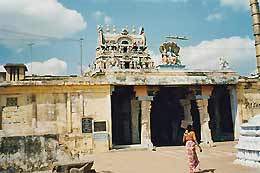 |
...Since all plants had
the same glare, Hanuman was in his search for medicine perplexed.
"If I cannot find the proper one, I will take the whole mountain
with me," told Hanuman to himself and started to lift it. Surprised
rishis fled and Hanuman flew to Lanka with the whole mountain in
his hand... |
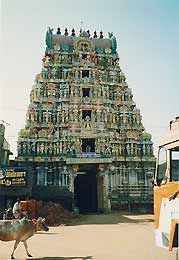 |
...In the meantime Jambhavan tied all death bodies of demos to
heavy stone and thrown them to ocean knowing that Pushpa-samjivani
will revitalize everybody present. Than the plant came and brought
back to consciousness Ram, Lakshman and the whole army of the
monkeys. Ramacandra finally won the battle of Lanka.
- Gate of the Ram Swami Temple.
|
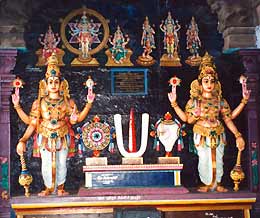 |
Jay and Vijay are doorkeepers
of Vaikuntha, spiritual world, guarding its entrance and not allowing
unqualified people to enter. In India we can often see their murti
at the entrance of the temples. Although we may not be qualified
to enter Vaikuntha, to the temple of Ram Swami we have been allowed... |
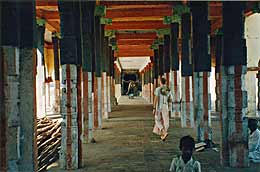 |
Mandapa (hallway) of Ram Swami Temple. |
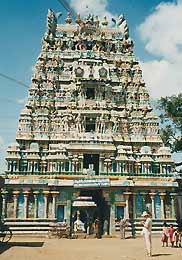 |
Cakrapani Temple
is dedicated to Sudarshana-chakra, the disk of Lord Vishnu, used
for killing demonic elements. Vishnu holds in His hands four symbols:
conchshell and louts flower used for blessings to pious and club
and disc for killing demons. His disc is called Sudarshana (literary
"auspicious vision"), because it sees all miscreants
in the same way and doesn't discriminate between small or great
demons. All are getting Sudarshana's mercy....
|
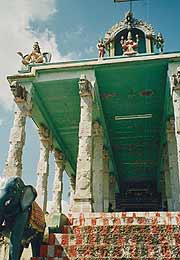 |
All light sources and illuminating objects like Sun and Moon
are reflecting the rays of Sudarshana-chakra. Sudarshana's light
enable us to distinguish one thing from the other, good and evil
and therefore it is related to knowledge and transcendental wisdom.
In Bhagavad-gita and other scriptures we can read phrases like
"the torchlight of knowledge" and "sword of detachment" and this
connection with Sudarshana-chakra can bring us better understanding
of those phrases.
The entrance to Cakrapani Temple.
|
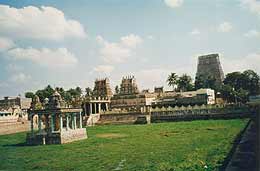 |
Once every 12 years a major festival is held at Mahamaham
Tank. On the full moon day in the mouth of Magha (Jan/Feb),
when Jupiter passes over Leo, the waters of Ganges, Yamuna and
seven other holy rivers are supposed to flow into the tank. Every
year there is smaller festival, but during last big one in 1992
as many as 2 million people gathered. The next scheduled major
festival will be in 2004.
|
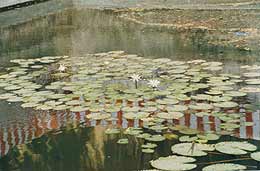 |
"Pankaja" means
"lotus" and it is favorite flower of Lord Krishna. |
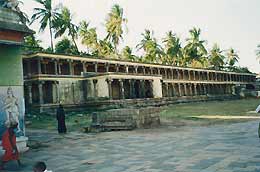 |
Brahmana ashram.
Formerly 3000 brahmanas lived in Kumbakonam and they took care
about temple worship and other different functions. Nowadays there
are about 300 brahmanas and they no longer live in those old ashrams.
They live in their own houses outside the temple area. Srila Prabhupada
considered mode of worship of South Indian brahmanas to be very
precise and if we want to learn Vedic rituals we should learn
it from them.
|
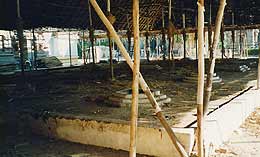 |
Yajna Tent where Vedic sacrifices
are held. We came just at the end of yajna. |
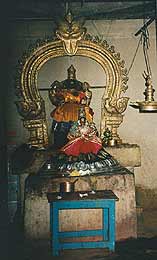 |
Kumbakonam is town with
many interesting people, shops and of course many temples of all
sizes. Some of them are huge and great and some are no bigger than
a case. |

























